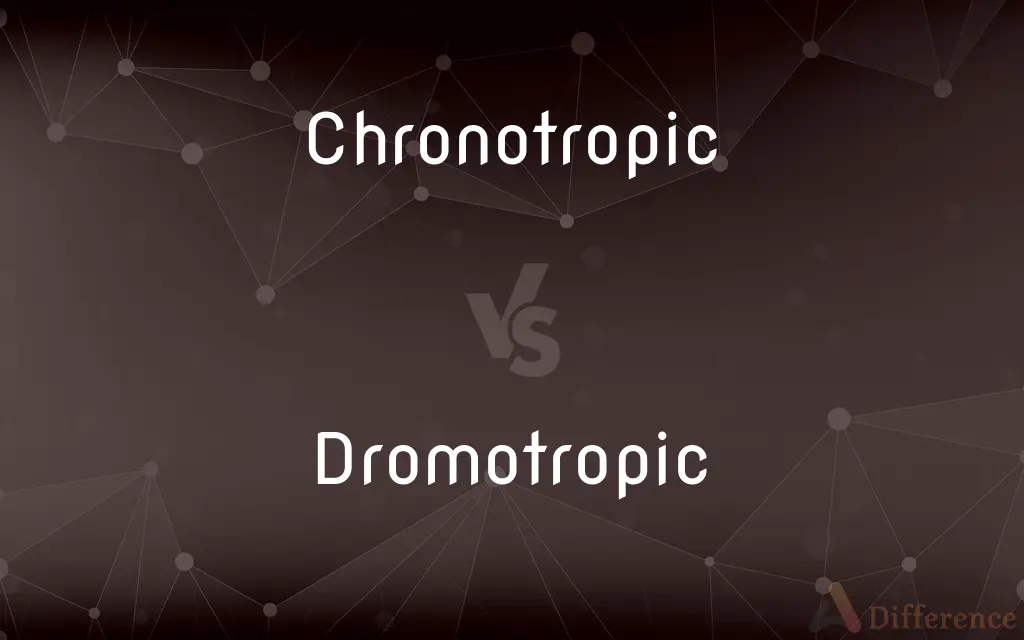Chronotropic vs. Dromotropic — What's the Difference?
By Tayyaba Rehman — Updated on September 28, 2023
Chronotropic effects influence heart rate, while dromotropic effects alter the conduction speed of the heart's electrical impulse. Both pertain to the heart's function but affect different aspects.

Difference Between Chronotropic and Dromotropic
Table of Contents
ADVERTISEMENT
Key Differences
Chronotropic and dromotropic are terms used to describe different effects on the heart's function. Chronotropic effects refer to changes in heart rate. A positive chronotropic effect increases the heart rate, while a negative one slows it down.
Dromotropic effects, on the other hand, deal with the conduction velocity of the heart's electrical impulse. A positive dromotropic effect accelerates the speed of this impulse through the atrioventricular (AV) node, whereas a negative effect slows it down.
When discussing cardiac medications or certain physiological conditions, it's important to understand these distinctions. For instance, certain drugs may have a negative chronotropic effect, meaning they are used to reduce an abnormally high heart rate. Simultaneously, other medications might be used to adjust the dromotropic effect, thus affecting the heart's electrical impulse conduction speed.
Both chronotropic and dromotropic effects play pivotal roles in maintaining cardiac health and rhythm. The balance between heart rate (chronotropic) and impulse conduction speed (dromotropic) ensures the heart functions efficiently, supplying the body with the oxygenated blood it needs.
In summary, while both chronotropic and dromotropic effects are crucial to the heart's function, they govern different aspects: the former manages the heart rate, and the latter oversees the speed at which electrical impulses travel through the heart.
ADVERTISEMENT
Comparison Chart
Relates to
Heart rate
Conduction speed of heart's electrical impulse
Positive Effect
Increases heart rate
Accelerates conduction speed
Negative Effect
Decreases heart rate
Slows down conduction speed
Commonly Influenced by
Catecholamines like adrenaline
Medications affecting the AV node
Physiological Importance
Determines the frequency of heartbeats
Influences the rhythm and synchrony of heartbeats
Compare with Definitions
Chronotropic
The effect that influences the heart's pacing.
The drug had a negative chronotropic effect, calming the rapid palpitations.
Dromotropic
Associated with the synchrony of heart's electrical activity.
Dromotropic agents can help ensure a steady and coordinated heartbeat.
Chronotropic
Reflecting changes in the heartbeat frequency.
Physical activity induces a positive chronotropic effect, raising heart rate.
Dromotropic
The effect impacting the conduction pace through the AV node.
By understanding the dromotropic properties, doctors could adjust the rhythm therapy.
Chronotropic
The descriptor for agents altering cardiac rhythm.
The doctor prescribed a chronotropic medication to manage the irregular heart rate.
Dromotropic
Reflecting shifts in the speed of heart's electrical signals.
A negative dromotropic impact was observed post the cardiac procedure.
Chronotropic
Relating to the speed of heart contractions.
Monitoring the chronotropic response is essential during cardiac stress tests.
Dromotropic
Concerning the alteration of the heart's electrical impulse speed.
The medicine's dromotropic effect stabilized the erratic conduction velocity.
Chronotropic
Pertaining to the modification of heart rate.
The chronotropic action of adrenaline increased the patient's heartbeat.
Dromotropic
Descriptor for substances modifying cardiac impulse transmission.
The new drug showcased dromotropic qualities, promising in arrhythmia treatments.
Chronotropic
Chronotropic effects (from chrono-, meaning time, and tropos, "a turn") are those that change the heart rate. Chronotropic drugs may change the heart rate and rhythm by affecting the electrical conduction system of the heart and the nerves that influence it, such as by changing the rhythm produced by the sinoatrial node.
Dromotropic
The term dromotropic derives from the Greek word δρόμος drómos, meaning "running", a course, a race. A dromotropic agent is one which affects the conduction speed (in fact the magnitude of delay) in the AV node, and subsequently the rate of electrical impulses in the heart.Positive dromotropy increases conduction velocity (e.g.
Chronotropic
(physiology) Of, relating to, or affecting the rate of muscular contraction, especially of the heart.
Dromotropic
(physiology) Affecting the conductivity of cardiac muscle, used of the influence of cardiac nerves.
Common Curiosities
What does chronotropic refer to?
Chronotropic refers to the effects influencing the heart rate.
How does dromotropic impact the heart?
Dromotropic effects alter the conduction speed of the heart's electrical impulse.
Can a substance have both chronotropic and dromotropic effects?
Yes, certain substances can influence both heart rate (chronotropic) and conduction speed (dromotropic).
How is a negative dromotropic effect beneficial?
A negative dromotropic effect can be useful in slowing down abnormally fast impulse conduction in certain arrhythmias.
What might cause a positive chronotropic effect?
Catecholamines like adrenaline can induce a positive chronotropic effect, increasing heart rate.
Which medications influence dromotropic effects?
Certain calcium channel blockers and beta-blockers can have dromotropic effects on the heart.
How are negative chronotropic agents used therapeutically?
They are often prescribed to patients with high heart rates to bring the rate down to a normal range.
How are chronotropic effects measured?
Chronotropic effects are assessed by monitoring changes in heart rate, typically using an electrocardiogram (ECG).
Are chronotropic effects always desirable?
Not always. Undesired positive chronotropic effects can lead to tachycardia, an abnormally high heart rate.
Why are dromotropic effects clinically important?
Dromotropic effects are crucial for ensuring the heart's electrical impulses are synchronized, preventing arrhythmias.
Share Your Discovery

Previous Comparison
Divestment vs. Divestiture
Next Comparison
Personification vs. ImpersonificationAuthor Spotlight
Written by
Tayyaba RehmanTayyaba Rehman is a distinguished writer, currently serving as a primary contributor to askdifference.com. As a researcher in semantics and etymology, Tayyaba's passion for the complexity of languages and their distinctions has found a perfect home on the platform. Tayyaba delves into the intricacies of language, distinguishing between commonly confused words and phrases, thereby providing clarity for readers worldwide.














































